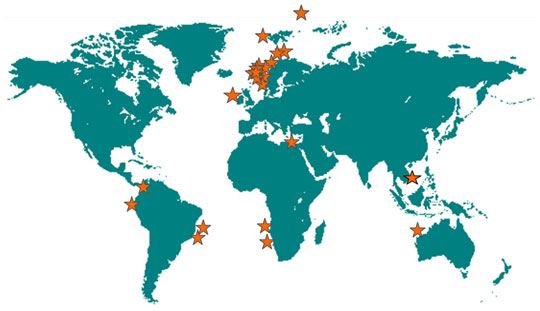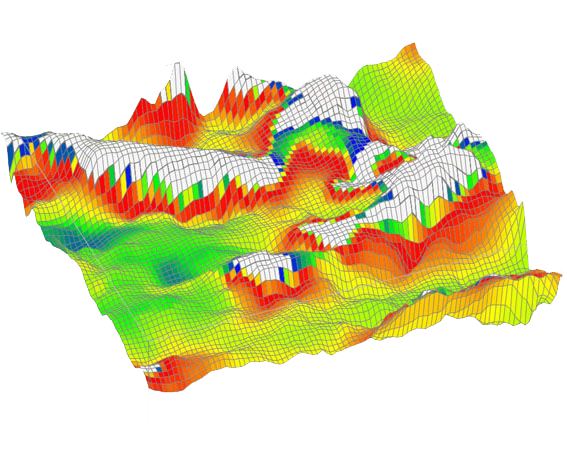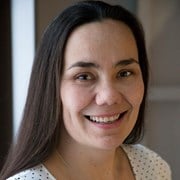Why model organic facies?
Modelling can provide a quantitative spatial and temporal distribution of organic matter in deposits where no measurements exist. By testing different conceptual input scenarios, a range of possible organic matter distributions can be simulated. Such testing further allows the identification of the most important geological and oceanographic parameters in the modelling area, and thus results in an improved understanding of the complex system under consideration.
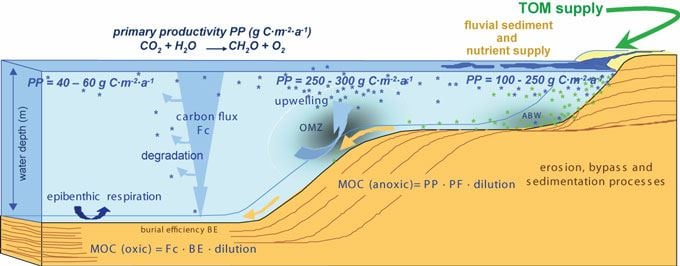
Modelling concept
The OF-Mod concept is based on the idea that the organic matter type, the preservation conditions during deposition and burial, and inorganic basin fill aspects are the most important factors influencing the temporal and spatial organic facies distribution in marine environments. All these model components are described using empirical equations. This mathematically simple approach means that the modelling is computationally inexpensive, and many simulations can be run in a short time.
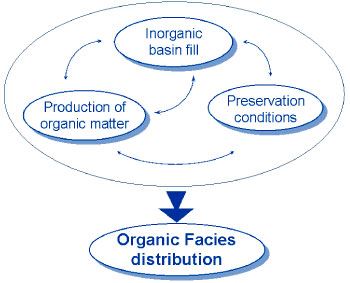
Production of organic matter
OF-Mod includes both marine and terrigenous organic matter. Marine organic matter depends on the primary productivity in the ocean surface waters, while terrestrial organic matter enters the basin either through rivers or as wind-blown material. Up to 50 % of the organic matter deposited at modern shelves can be of terrigenous origin and even more at huge river mouths like at the Amazon Shelf, so it is important to include this type of organic matter.
Marine organic matter
In OF-Mod, primary productivity of marine organic matter (PP) is defined as a function of the distance from shore: PP is higher close to the coast, where enhanced nutrient supply form the hinterland occurs, than in distal basin positions. Additionally, areas of higher productivity can be defined to represent e.g. river input or upwelling scenarios.
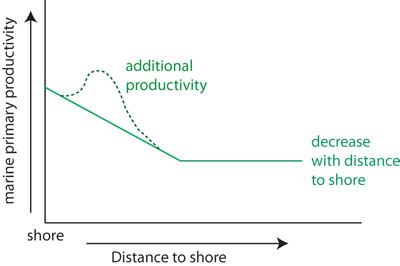
Several authors have estimated the carbon flux to the sea floor by correlating the primary produced organic matter (PP in gCm-2a-1) to water depth. This approach is also applied in OF-Mod when oxic water conditions are assumed.
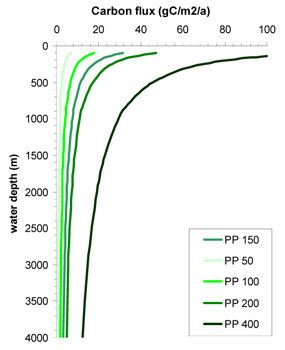
Carbon flux - water depth relationship according to Stein (1991).
Terrigenous organic matter
In OF-Mod the terrigenous organic matter fraction is modelled as being dispersed dependent on the inorganic grain size distribution (Bergamaschi et al., 1997; Keil et al., 1998). The particulate land plant debris is coupled to the coarse grain size fractions (sand) as both are more common in near shore areas. Heavily degraded and/or residual allochthonous organic matter is associated with the fine grain size fractions (shale).

The particulate organic carbon fraction is modelled as a function of the sand content of the sediments.
Preservation conditions
Oxygen conditions in the water column and near the sea floor affect the preservation of organic matter after burial, especially the more labile marine fraction.
Oxygen depletion in the water column is regarded as the main factor leading to improved organic matter preservation. In OF-Mod, two scenarios representing oxygen deficiency in the water column can be chosen:
- oxygen minimum zones, related to surface water productivity
- anoxic bottom water, which can result from sluggish circulation or stagnation of water masses
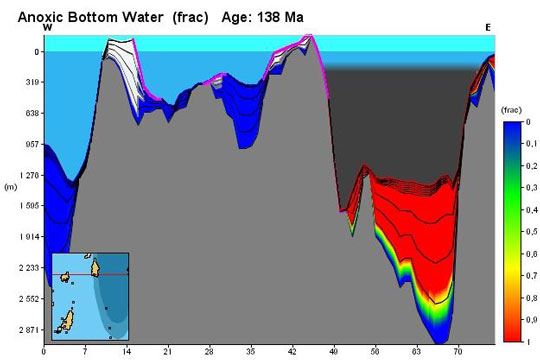
In this cross-section the basin to the right was defined to have an anoxic water column. This can result in improved preservation of the organic matter in the sediments.
Modelling results and output data
Parameters used in determining the inorganic basin fill model, and the organic parameters can be saved as output.
All parameters used in determining the inorganic basin fill model (sand fraction, sedimentation rate,...), as well as the organic parameters (TOC, individual matter fractions,...) can be saved as output. In addition, derived parameters such as Hydrogen Index (HI), δ13C and source rock potential (poor, fair, good, or very good), can be exported.
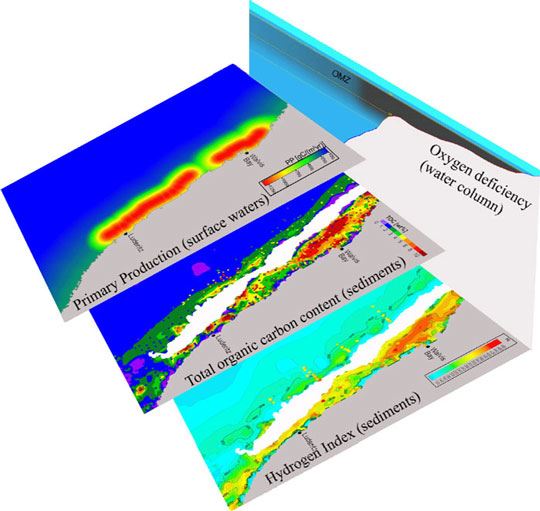
OF-Mod model results of the modern high-productive Benguela upwelling area offshore south-western Africa.
TOC and HI values can be compared with measured values from cores, and can thus be used to calibrate the model.
OF-Mod representation of the modern high-productive Benguela upwelling area offshore south-western Africa.
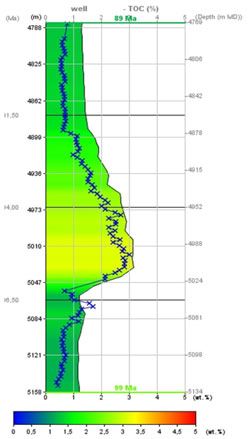
Comparison of modelled TOC values (colours) with measured TOC values. The slight overestimate of the modelled results is due to the maturity of the measured values, which causes a decrease of the present-day values with respect to the values at the time of deposition.
The results can be exported as 3D grid data (GRDECL-format), but can also be displayed and exported as maps (ZMap+, Irap ASCII classic, xyz-format). Using these formats, the results can be imported easily in another basin simulator such as SEMI, for HC charge or entire petroleum systems modelling.
Literature
The following peer-reviewed papers have been published so far, describing or using OF-Mod.
Knies, J. and Mann, U., 2002. Depositional environment and source rock potential of Miocene strata from the central Fram Strait: introduction of a new computing tool for simulating organic facies variations. Marine and Petroleum Geology, 19(7): 811-828.
Mann, U. and Zweigel, J., 2008. Modelling source rock distribution and quality variations: The OF-Mod approach. In: Analogue and Numerical Forward Modelling of Sedimentary Systems; from Understanding to Prediction (P.L. de Boer, G. Postma, C.J. van der Zwan, P.M. Burgess and P. Kukla, eds.). Special Publication 40 of the International Association of Sedimentologists, pp. 239-274.
Tømmerås, A., and Mann, U., 2008. Improved hydrocarbon charge prediction by source-rock modelling. Petroleum Geoscience, 14(3), pp. 291-299.
Mann, U., Knies, J., Chand, S., Jokat, W., Stein, R., Zweigel, J., 2009. Evaluation and modelling of Tertiary source rocks in the central Arctic Ocean. Marine and Petroleum Geology 26 (8), 1624-1639.
Additionally, many results of studies with the OF-Mod software have been presented at international conferences.
Input data
Input for the inorganic basin fill modelling consists of:
- surface maps of the modelling interval (present day geometries) with their corresponding ages
- palaeo-bathymetry reconstructions horizons within the interval
- sand/shale ratios from wells
- sea level curve
Seismic interpretation and well data

Information from wells or from sea-floor measurements can be used for calibration and/or for developing scenarios for the organic model part:
- total organic carbon content (TOC)
- Rock Eval data (HI, Tmax)
- biomarkers (e.g. n-alkane distribution), stable C isotopes (13C) and/or microscopy data (maceral distribution or palynofacies analysis)
Palaeobathymetry
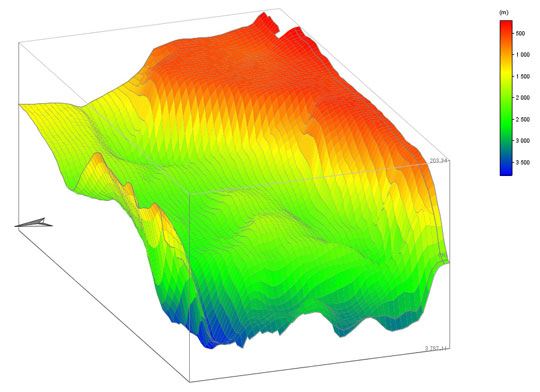
Inorganic basin fill
Knowledge of the inorganic basin fill and basin configuration is important for organic sedimentation modelling.
Knowledge of the inorganic basin fill and basin configuration is important for organic sedimentation modelling because
- lithology affects preservation: different types of organic material are preferentially preserved in material with different grain sizes (Bergamaschi et al., 1997; Keil et al., 1998),
- sedimentation rate influences both the oxygen exposure time, and the relative amount of organic material in the total deposit,
- shoreline position (and thus sea level) is relevant for marine primary productivity as this is higher close to shore than far away from shore, and for supply of terrestrial organic matter which also decreases away from the shore,
- carbon flux to the sea floor depends on water depth: the deeper the water, the less organic material reaches the bed due to degradation/combustion while sinking through the water column.
The basin fill stratigraphy can be created inside OF-Mod with the Stratigraphy Builder Module. It can also be imported from stratigraphic forward modelling tools (e.g. DIONISOS) or from deterministic reservoir modelling tools (e.g. Irap RMS, Petrel).
The stratigraphy builder uses present-day geometry maps to calculate sedimentation rates (through decompaction), palaeo-water depth reconstructions are used to determine distance to shore and water depths, and sand or shale fractions measured in wells are used to determine lithology.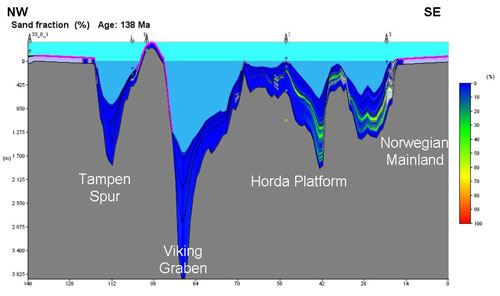
Cross section showing the modelled sand fraction in the Heather and Draupne formations in the Norwegian North Sea.
Bergamaschi, B.A., Tsamakis, E., Keil, R.G., Eglinton, T.I., Montlucon, D.B., and Hedges, J.I., 1997, The effect of grain size and surface area on organic matter, lignin and carbohydrate concentration, and molecular compositions in Peru Margin sediments: Geochimica et Cosmochimica Acta, v. 61, p. 1247-1260.
Keil, R.G., Tsamakis, E., Giddings, J.C., and Hedges, J.I., 1998, Biochemical distribution (amino acids, neutral sugars, and lignin phenols) among size-classes of modern marine sediments from the Washington coast: Geochimica et Cosmochimica Acta, v. 62, p. 1347-1364.
Application areas
OF-Mod 3D has been applied in both research studies and in consultancy case studies for industry in different parts of the world.
Research studies, alone or in collaboration with academia, aim to use modelling to understand the influences on organic carbon deposition. This knowledge is then used in developing methodology that can be implemented in OF-Mod 3D to simulate organic carbon deposition and burial, based both on local knowledge (from e.g. wells) and on process knowledge (such as the influence of sea level on the input variables used in the model).
Source rock distribution predictions have been made with OF-Mod 3D for several areas. Such predictions are for example part of the Basin Modelling integrated studies for the Barents Sea and the Norwegian Shelf. In these studies the OF-Mod 3D results were used as input for the generation, expulsion and migration modelling in SEMI. See the literature list for published results of some other studies. See the following posters for examples presented at conferences:
- Inthorn et al. IMOG 2007,
3D Source Rock Modelling of the Late Jurassic Vøring Basin off Mid-Norway (pdf) - Guzzo et al. AAPG 2009,
3D source-rock modelling of the Espirito Santo Basin, Brazil (pdf)
If you would like us to perform a case study for you, please get in touch with Ansattinfo mangler.
